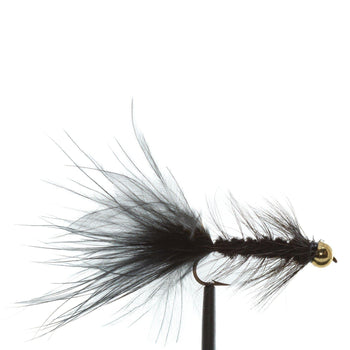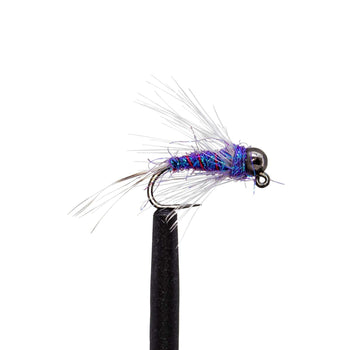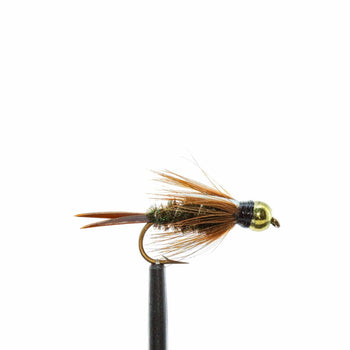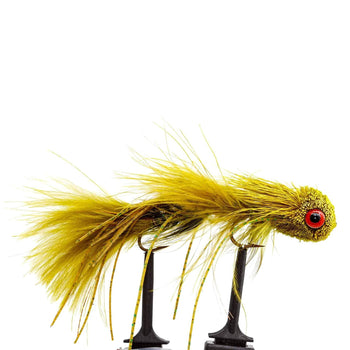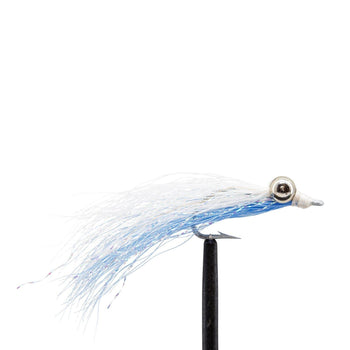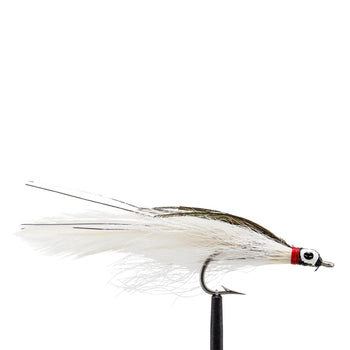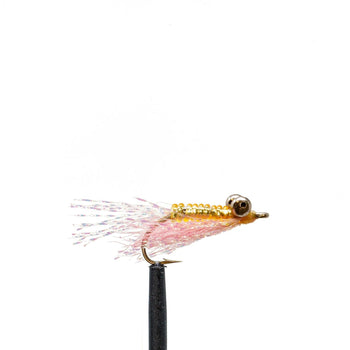How and Why to Fly Fish with Weighted Flies: Unlocking the Secrets of Coneheads, Beadheads, and Dumbbells

Embarking on a fly fishing journey unveils a spectrum of strategies, each woven into the very essence of this time-honored sport. At the heart of innovation and technique are the weighted flies: coneheads, beadheads, and dumbbells, each bringing a special touch to the fishing experience. These weighted flies are crucial tools that help in precisely targeting fish, adding depth and detail to the fishing process. While choosing among these options might seem overwhelming, understanding their unique roles and functions will guide you through making the best selections for a successful fishing adventure.
Beadheads: The Versatile Attractor
Beadheads add a subtle touch of weight and visual appeal to flies, helping them catch the eye of fish in various water conditions. The small, shiny bead adds a sparkle, making the fly more noticeable and attractive underwater. Suitable for both moving river currents and calm lake waters, beadheads enhance different types of flies, from slow-moving nymphs to lively streamers, making them more effective and versatile in attracting fish.
Coneheads: Masters of Depth and Motion
Coneheads are uniquely designed weighted flies that enhance your fishing experience by adding a realistic touch to your fly’s movement in water. Their conical weight helps the fly to sink head-first, mimicking the motion of injured or escaping prey. This makes the fly more attractive to fish, especially in fast-moving waters or deeper areas where fish hide. With a conehead, your fly is more likely to catch the attention of fish due to its distinctive, lifelike motion.
Dumbbells: The Architects of Action
Dumbbells add dynamic movement to flies, creating a lively, side-to-side action that mimics real aquatic life, like baitfish or crustaceans, trying to escape predators. This design is particularly effective in saltwater, where the realistic motion helps the fly navigate the challenging tides, making it more appealing to the fish in the vast ocean environment. Dumbbells don’t just help the fly sink; they enhance its overall performance and attractiveness by making it move more naturally in the water.
Navigating the Choices with Knowledge
Choosing the right weighted fly—whether it’s a conehead, beadhead, or dumbbell—is about understanding and adapting to the fishing environment. It requires considering various factors like water conditions, weather, and the type of fish you’re targeting. With knowledge of how each weighted fly functions and what it offers, you can make strategic decisions that enhance your chances of success and enjoyment in fly fishing. Armed with this understanding, you can tailor your approach to resonate with the natural rhythms of the water, improving your overall fly fishing experience.

Understanding the Weight Options
Beadheads
- Material and Shape: These are metallic beads fixed on the fly’s hook shank.
- Purpose: They offer subtle weight and a shimmering attraction, making the fly appealing to fish.
- Common Usage: Versatile, beadheads are suitable for various flies ranging from nymphs to streamers.
Coneheads
- Material and Shape: Made from metals or plastics, coneheads are cone-shaped weights added to the front of the fly.
- Purpose: They promote a head-first sinking motion and a jigging action in the fly.
- Common Usage: Predominantly used in streamers and woolly buggers to mimic fleeing or injured prey.
Dumbbells
- Material and Shape: Shaped like eyes or elongated weights, they’re attached to the fly’s sides.
- Purpose: They provide a unique side-to-side action to the fly.
- Common Usage: Frequently found in saltwater flies like the Clouser Minnows.
Choosing the Right Weight: Tungsten vs. Lead
Tungsten
- Density: Being denser than lead, tungsten allows for more weight in a smaller size.
- Environmental Impact: A safer choice, tungsten is less harmful to aquatic life.
- Preference: Many anglers favor tungsten for its efficient sinking capability and compactness.
Lead
- Availability: Traditionally popular due to its accessibility and ease of use.
- Environmental Impact: Its toxic nature poses risks, leading to its restricted use in some areas.
- Consideration: Despite its efficacy, the ecological concerns make tungsten a preferable alternative.
Using Split Shot for Quick Adjustments
Split shots offer a practical alternative to built-in weights, allowing for adaptable depth control. They can be added or removed from the leader, offering flexibility to manage your fly’s depth based on changing water conditions or when using unweighted flies like dry flies or emergers.
Beadheads
Beadhead flies have become a staple in the fly angler's arsenal due to their versatility and effectiveness across a wide array of fishing scenarios. The beadhead serves multiple essential functions: it adds weight to the fly, aiding in achieving the desired depth more quickly and maintaining a position in swifter currents; and it introduces a sparkle that can captivate the attention of fish, enhancing the overall attractiveness of the fly. When using a beadhead fly, allowing it to drift naturally with the currents is often key; the added weight of the bead facilitates this, making the fly’s movement more convincing and lifelike. Moreover, beadhead flies are adaptable to various retrieves and can mimic a diverse range of aquatic life from nymphs to baitfish. Their design and action make them particularly useful in waters with a significant amount of underwater activity, such as during hatch seasons, enabling anglers to take advantage of the heightened feeding activity of fish. Choosing beadhead flies offers anglers a potent tool to navigate the challenges and variances presented by different water bodies and fishing conditions.
RECOMMENDED BEADHEAD FLIES
1. Beadhead Pheasant Tail Nymph
- How to Use: Great for dead drifting in rivers to imitate natural nymphs.
- When to Use: Effective during nymph hatches, primarily in spring and early summer.
- Why It’s Great: The Beadhead Pheasant Tail Nymph is versatile, effective in various water conditions. Its weight and flash enhance appeal, accurately mimicking natural nymphs and increasing the chances of attracting fish.
- How to Use: Adapted for various retrieves, the Beadhead Wooly Bugger is versatile, capable of imitating leeches, baitfish, and other forms of aquatic life.
- When to Use: This pattern is incredibly versatile, suitable for use throughout the year across diverse water bodies and conditions.
- Why It’s Great: The added beadhead enhances the Wooly Bugger’s natural movement and sink rate, making it more effective in deeper or faster waters. The subtle flash of the bead also adds an extra element of attraction, helping to draw in fish from a distance, making it a go-to fly for various fishing scenarios.
- How to Use: The weighted head facilitates a jigging action, enabling the fly to be effective in both still and moving waters.
- When to Use: It shines across seasons due to its capacity to convincingly mimic a variety of nymph species.
- Why It’s Great: The tungsten bead in the Duracell Jig significantly enhances the fly’s sinking speed, allowing it to reach the desired depth more quickly. Its unique design and jigging action make it irresistible to fish, improving the chances of attracting and catching diverse fish species in various water conditions. The use of tungsten also adds an eco-friendly aspect, as it is a non-toxic alternative to lead.
4. Beadhead Hare’s Ear Flashback
-
How to Use: This fly is best fished near the bottom, using occasional twitches to simulate the natural movement of nymphs and other aquatic life.
-
When to Use: Optimal in spring and fall, aligning well with major insect hatches, making it a timely and attractive choice for fish.
-
Why It’s Great: The Beadhead Hare’s Ear Flashback stands out due to its reflective flashback, which adds an enticing flash in the water, catching the eye of fish. Combined with the beadhead, it sinks effectively to the desired depth, making it ideal for reaching fish in deeper or faster-moving waters. Its realistic design and movement mimic various aquatic life stages, enhancing its versatility and effectiveness in attracting diverse fish species.
-
How to Use: Allow the Beadhead Prince Nymph to drift naturally with the current, effectively mimicking the behavior of native nymphs in the water.
-
When to Use: A versatile option, the Prince Nymph is effective year-round, aligning well with various insect hatching seasons.
-
Why It’s Great: The Beadhead Prince Nymph is cherished for its universal appeal and adaptability. The beadhead ensures the nymph sinks swiftly to the desired depth, placing it directly in the feeding zone of fish. The weight and shine of the bead also enhance the nymph’s movement and visibility underwater, making it even more irresistible to fish. Its design allows it to mimic various natural nymphs, increasing its effectiveness across different water bodies and seasons.
SHOP ALL BEADHEAD PATTERNS
Coneheads
Conehead fly patterns are uniquely designed to optimize an angler's success in diverse aquatic environments. The distinct cone-shaped weight at the front of the fly ensures a rapid, head-first descent, allowing the fly to penetrate deeper waters and navigate swift currents effectively. This design also imparts a tantalizing jigging action, mimicking the vulnerable movements of injured prey, thereby captivating the attention of predatory fish. Conehead patterns are particularly advantageous in varied water structures, enabling the angler to explore different depths and target aggressive, strike-prone species with a more dynamic and realistic presentation. Their adaptability and life-like action make conehead flies an indispensable asset for achieving fly fishing success across a multitude of scenarios.
RECOMMENDED CONEHEAD PATTERNS
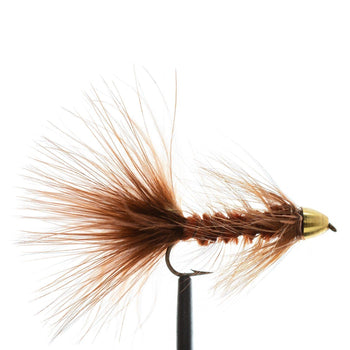
|
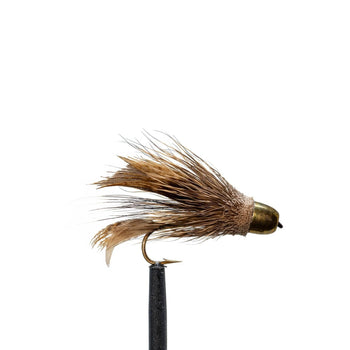
|
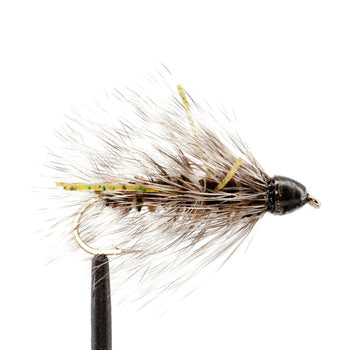
|

|
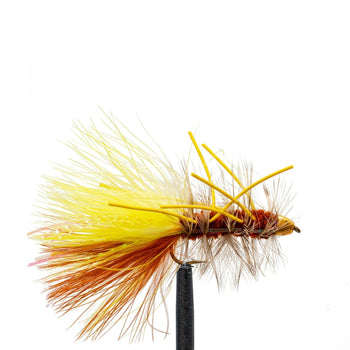
|
| Conehead Wooly Bugger | Conehead Muddler Minnow | Conehead Yuk Bug | Conehead Rubber Legs | Conehead JJ Special |
-
How to Use: Cast into deeper pools or in areas with faster currents, allowing it to sink near the bottom. Retrieve the fly using short, erratic pulls to mimic the movements of an injured baitfish.
-
When to Use: Optimal for use in early spring or fall seasons when fish tend to be more aggressive and in search of larger prey.
-
Why It’s Great: The Conehead Wooly Bugger stands out due to its ability to reach desired depths quickly and its effectiveness in attracting predatory fish with its distinctive, erratic movement. The conehead not only helps in sinking the fly but also in enhancing the injured prey illusion with its jigging action, making the fly almost irresistible to fish. The design is versatile and performs exceptionally well in various water conditions, presenting an essential option for anglers aiming for success in deeper waters and faster currents.
-
How to Use: The Conehead Muddler Minnow is best used by swinging it across currents or stripping it through slower pools to mimic the movements of smaller baitfish or aquatic creatures.
-
When to Use: This fly pattern shines particularly during the late spring or summer evenings when fish are more active and looking for prey near the surface.
-
Why It’s Great: The Conehead Muddler Minnow’s design allows it to exhibit enticing movement patterns that captivate predatory fish. Its conehead ensures that the fly can cut through fast currents with ease, allowing for a versatile range of retrieval techniques. The weighted head also helps the fly dive quickly in the water column, offering a more realistic presentation that effectively targets a diverse array of fish species, making it a powerful ally in the hands of an angler during the warmer and more active months.
-
How to Use: The Conehead Yuk Bug is versatile, suitable for both streams and still waters. It can be dead drifted or retrieved with short, jerky motions to impersonate a distressed nymph or bug.
-
When to Use: This fly is particularly effective during warmer months when aquatic insects are more active but is versatile enough to be utilized effectively throughout various fishing seasons.
-
Why It’s Great: The Conehead Yuk Bug offers incredible adaptability in its application, allowing it to be a standout option in various water types and conditions. The conehead adds the necessary weight, enhancing its ability to sink to the desired depth quickly, making the presentation more attractive to the target fish. The fly's design and recommended retrieval techniques effectively mimic natural prey, increasing the likelihood of attracting and catching fish during outings, especially when aquatic insects are prevalent in the water.
-
How to Use: With its animated rubber legs, this fly is perfected for dead drifting in currents or slowly retrieving in still waters. It imitates aquatic insects or small crayfish with added realism due to the additional movement.
-
When to Use: This fly is particularly effective during warmer months when aquatic insects are more active but is versatile enough to be utilized effectively throughout various fishing seasons.
-
Why It’s Great: The Conehead Yuk Bug offers incredible adaptability in its application, allowing it to be a standout option in various water types and conditions. The conehead adds the necessary weight, enhancing its ability to sink to the desired depth quickly, making the presentation more attractive to the target fish. The fly's design and recommended retrieval techniques effectively mimic natural prey, increasing the likelihood of attracting and catching fish during outings, especially when aquatic insects are prevalent in the water.
-
How to Use: Suitable for stripping or swinging in rivers and streams, the Conehead JJ Special effectively mimics baitfish or leeches due to its thoughtful design.
-
When to Use: It shines in clearer waters where its intricate design can captivate predatory fish, allowing for flexibility across various seasons based on the conditions of the local ecosystem.
-
Why It’s Great: The Conehead JJ Special stands out due to its meticulously crafted design that presents a highly realistic imitation of natural prey such as baitfish or leeches. The conehead adds necessary weight, ensuring that the fly maintains an appropriate depth, optimizing the chances of attracting predatory fish. The fly’s adaptability across different water clarity conditions and seasons enhances its utility, making it a valuable asset for anglers aiming for success in diverse fishing environments and scenarios. Its suitability for various retrieval techniques, like stripping or swinging, adds to its allure, offering anglers a versatile tool to adapt to the preferences and behaviors of the target fish.
SHOP ALL CONEHEAD PATTERNS
Dumbbells
Dumbbell flies are a powerful asset for anglers, enhancing the realism and appeal of fly presentations in both freshwater and saltwater environments. Their unique design, featuring dumbbell eyes, adds necessary weight, enabling the fly to sink effectively while also introducing an erratic, side-to-side motion that mimics vulnerable prey, such as baitfish or fleeing crustaceans. This distinctive action is especially enticing to predatory species, encouraging aggressive strikes and improving the angler’s chances of success. Dumbbell flies offer versatility and adaptability, allowing for a wide range of applications across various currents, depths, and target species, making them an essential component in a well-rounded fly fishing strategy.
RECOMMENDED DUMBBELL FLIES
-
How to Use: Ideal for stripping and retrieving in a variety of water types. Its design allows it to move enticingly through the water, making it appealing to predatory fish.
-
When to Use: Particularly effective in clear waters where the articulated design can be seen and appreciated by predatory fish, suitable across various seasons.
-
Why It’s Great: Its articulated body and overall design make the fly move naturally, enticing strikes from aggressive fish such as trout and bass.
-
How to Use: Best used with a sinking line, allowing it to get close to the bottom. Its design allows it to mimic baitfish, making it suitable for a variety of retrieves.
-
When to Use: Highly versatile and can be used year-round in various water types, including saltwater.
-
Why It’s Great: The dumbbell eyes give it a jigging motion that mimics a baitfish, making it irresistible to predatory species like bass and pike.
-
How to Use: Suitable for large rivers and streams, its design allows for an erratic motion when retrieved, mimicking distressed baitfish or other aquatic life.
-
When to Use: Effective across seasons but performs exceptionally well during warmer months when fish are more active.
-
Why It’s Great: The articulated design and colorful patterns make it visually appealing, triggering strikes from a variety of fish species.
-
How to Use: Can be used in both freshwater and saltwater, ideal for imitating baitfish with its slender profile and natural movement.
-
When to Use: Versatile enough for year-round use but exceptionally effective when baitfish are prevalent.Its natural movement and ability to mimic a variety of baitfish make it a staple in the saltwater fly fisher’s box.
-
Why It’s Great: Its natural movement and ability to mimic a variety of baitfish make it a staple in the saltwater fly fisher’s box.
-
How to Use: Ideal for flats fishing, it is used primarily for bonefish but also effective for other species. Retrieve it with short, sharp tugs to imitate a fleeing shrimp or crab.
-
When to Use: Particularly effective in clear, shallow waters where visibility is high.
-
Why It’s Great: Its simplicity and effectiveness in mimicking crustaceans make it a go-to fly for targeting species like bonefish in shallow waters.
SHOP ALL DUMBBELL PATTERNS
Weighted flies stand as formidable allies in the intricate ballet of fly fishing, bringing a nuanced dynamism and versatility to your angling arsenal. They are the unsung heroes that dramatically enhance the authenticity of your presentation, imbuing each cast with a lifelike grace and precision that proves irresistible to the underwater inhabitants of rivers and oceans. Coneheads, beadheads, and dumbbells each bring their unique language of movement, allowing your flies to dive, dance, and dart through the aquatic realms with an enthralling allure. By strategically choosing between these weights, and materials such as tungsten and lead, you craft a tailored symphony of tactics that resonate with the specific rhythms of diverse fishing environments. This curated approach facilitates a harmonious dialogue between angler and nature, where each cast tells a story woven into the fabric of the waters you navigate. Understanding and mastering the subtle art of weighted flies unlocks new dimensions of creativity and effectiveness in your fly fishing journey. It paves the way for a richer, more rewarding experience, where each outing becomes a finely tuned exploration of skill and intuition. So, embark on a journey of discovery with weighted flies, and allow their transformative power to elevate your fly fishing adventures to realms of unprecedented success and enjoyment.




